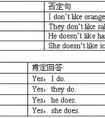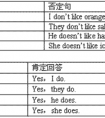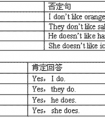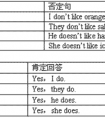句型转换。1. Sheismakingdumplings. (对画线提问)_____________________________________________2.Openyoureyes. (改为相反意思的句子)_____________________________-六年级英语
① 树叶半数自已黄,妻子拿刀去割粮,架后窜出一只狼,就像强盗逃命忙。
② 妻子持刀去宰狼,小偷吓得发了慌,躲在架后保己命,半片树叶遮目光。
例如:leaf (树叶,叶子),half (一半),self (自已),wife (妻子),knife (刀子),shelf (架子),wolf (狼), thief (窃贼,强盗) 和 life (生命),
这些名词变成复数时,都要改 -f (e) 为 v,再加 -es。
3. -f 结尾的名词直接加 -s 变复数歌诀:海湾边、屋顶上,首领奴仆两相望;谁说他们无信仰,证据写在手帕上。
例如:gulf, roof, chief, serf, belief, proof, handkerchief,这些名词变复数直接加 -s。
注:scarf(围巾;披风) 可以先改 f 为 ve 再加-s,也可直接加 -s。
4. 辅音字母 + y 结尾的名词,把 y 变 i 加 -es。
例如:baby → babies, country → countries, family → families;而 -y 前是元音时,-y 不变,直接加 -s。例如:day → days, boy → boys
5. 以 -o 结尾的名词变复数时,多数直接加 -s。
例如:radio → radios, piano → pianos, kangaroo → kangaroos;有的须加 -es,中学课本中有几个这样的单词,可以通过一句口诀来记忆:黑人英雄爱吃西红柿和土豆。
即:Negro → Negroes, hero → heroes, tomato → tomatoes, potato → potatoes;有的以 o 结尾的名词既可加 -s 也可加 -es。
例如:volcano (火山) → volcanos / volcanoes 等。
6. 名词复数的不规则变化需要特别记忆。
例如:man → men, woman → women, goose → geese, foot → feet, tooth → teeth, mouse → mice, louse (虱子) → lice, child → children, fish → fish, deer (鹿) → deer, sheep → sheep 等。
7. 初中课本中表示“某国人”的名词复数形式变化可通过歌诀记忆:中日不变英法变,其余 -s 加后面。
例如:Chinese → Chinese, Japanese → Japanese;
Englishman → Englishmen, Englishwoman → Englishwomen, Frenchman → Frenchmen, Frenchwoman → Frenchwomen;
American → Americans, Rusian → Rusians, Arab → Arabs, German → Germans 等。
8. 不可数名词一般只有单数形式,没有复数形式。有些不可数名词可借助单位词表示一定的数量。
例如:a cup of tea 一杯茶
, two piece of paper 两张纸, an item of news 一则新闻
考点名称:指示代词
指示代词:
是表示指示概念的代词,即用来指示或标识人或事物的代词。
指示代词与定冠词和人称代词一样,都具有指定的含义,用来起指示作用,或用来代替前面已提到过的名词。
指示代词分单数(this/that)和复数(these/those)两种形式,既可作限定词又可做代词,
例如:单数复数
限定词:This girl is Mary.Those men are my teachers.
代词:This is Mary. Those are my teachers.指示代词用法:
1、this和these指在时间或空间上较近的人或者事物,that和those指在时间或空间上较远的人或者事物。如:
This is a pen and that’s an eraser. 这是一支笔,那是块橡皮擦。
This is a boy and those are girls. 这是个男孩,那些是女孩。
2、指示代词所指的对象取决于说话者和听话者共同熟悉的语境。如:
I liked this movie today better than that concert last night.
我喜欢今天的这个电影,胜过昨晚的那个音乐会。
3、指示代词具有名词和形容词性质,既可指人也可指物。但是在相当于名词时一般指物多于指人。如:
I found this wallet. I found this.我找到了这只皮夹子。我找到了这个。(this 等于 this wallet)
Is she going to marry that man?她打算跟那人结婚吗?(that man不得用that代替,否则有轻蔑之意)
4、相当于名词的指示代词在句中作主语时,则指物指人均可。如:
What are these? 那些是什么?(指物)
This is Bill. Is that George? 我是比尔。你是乔治吗?(电话用语)(指人)
5、打电话过程中,介绍自己时通常用this指代“我”,不用代词I;询问对方时用that指代“你”,不用代词you。如:
Hello. This is Mary. Who’s that? 喂,我是玛丽。你是谁?
This is Tom. 我是汤姆。
6、当指示代词所指的事物已确定时,后面的指示代词则用it或they代替。如:
This (suit) is expensive, isn't it? 这套衣服昂贵,不是吗?
"Are those yours?" "Yes, they are." “那些是你的吗?”“是的,它们是我的。”
考点名称:副词
- 副词:
用来修饰动词、形容词、其他副词或全句的词,表示时间、地点、程度、方式等。 - 分 类:
1) 时间和频度副词:
now,then,often,always,usually,early,today, lately, next,last,already,generally,frequently, seldom,ever,never,yet,soon,too, immediately, hardly,finally,shortly, before, ago,sometimes, yesterday.
2) 地点副词:
here, there, everywhere, anywhere, in, out, inside, outside, above, below, down, back, forward, home, upstairs, downstairs, across, along, round , around, near, off, past, up, away, on.
3) 方式副词:
carefully, properly, anxiously, suddenly, normally, fast, well, calmly, politely, proudly, softly, warmly
4) 程度副词:
much,little, very,rather,so,too,still, quite, perfectly, enough, extremely, entirely,almost, slightly.
5) 疑问副词:
how, when, where, why.
6) 关系副词:
when, where, why.
7) 连接副词:
how, when, where, why, whether. 副词的位置:
A、副词修饰动词(包括动名词和分词)时,通常位于被修饰动词的后面。
例:Shestudieshard.她学习努力。
B、副词修饰形容词是,通常放在该形容词的前面。
例:LiMingistooyoung.Hecan’tcarrytheheavybox. 李明太小,他搬不动这个重箱子。
C、副词修饰其他副词时,通常放在被修饰副词的前面。
例:Thegirlsingsverywell.这个女孩歌唱得非常好。副词用法:
副词在句中可作状语,表语,补语。
He works hard.
他工作努力。
You speak English quite well.
你英语讲的很好。
Is she in ?
她在家吗?
Let's be out.
让我们出去吧。
Food here is hard to get.
这儿很难弄到食物。
考点名称:介词
- 介词:
是用来表示它后面的名词(代词)或起名词作用的短语、从句与句中其他成分之间的关系。
介词是英语中很活跃的词,一般置于名词之前。它常和名词或名词性词语构成介词短语。
同一个介词常和不同的词语搭配形成固定搭配,表示不同意义。 介词分类:
一、表示地点位置的介词
(1)at, in, on, to, for
at 表示在小地方;表示“在……附近,旁边”。
in 表示在大地方;表示“在……范围之内”。
on 表示毗邻,接壤,“在……上面”。
to 表示在……范围外,不强调是否接壤;或“到……”。
(2)above, over, on 在……上
above 指在……上方,不强调是否垂直,与below相对;
over 指垂直的上方,与under相对,但over与物体有一定的空间,不直接接触。
on 表示某物体上面并与之接触。
例:The bird is flying above my head. 小鸟在我的头上飞。
There is a bridge over the river. 在河上有一座桥。
He put his watch on the desk.他把他的表放在了桌子上。
(3)below, under在……下面
under 表示在……正下方
below 表示在……下,不一定在正下方
例:There is a cat under the table. 桌子底下有一只猫。
- 最新内容
- 相关内容
- 网友推荐
- 图文推荐
| [家长教育] 孩子为什么会和父母感情疏离? (2019-07-14) |
| [教师分享] 给远方姐姐的一封信 (2018-11-07) |
| [教师分享] 伸缩门 (2018-11-07) |
| [教师分享] 回家乡 (2018-11-07) |
| [教师分享] 是风味也是人间 (2018-11-07) |
| [教师分享] 一句格言的启示 (2018-11-07) |
| [教师分享] 无规矩不成方圆 (2018-11-07) |
| [教师分享] 第十届全国教育名家论坛有感(二) (2018-11-07) |
| [教师分享] 贪玩的小狗 (2018-11-07) |
| [教师分享] 未命名文章 (2018-11-07) |


![____________doyoulike?[ ]A.WhatB.HowC.What's-三年级英语](http://www.00-edu.com/d/file/ks/4/1/26/2019-08-17/smalld0069ba33c4a9e98616d410691314d1e1565980468.png)



